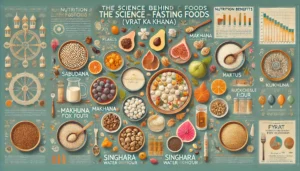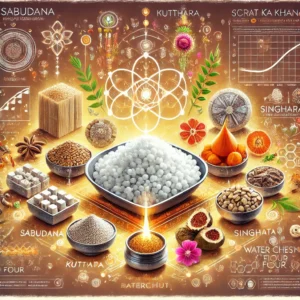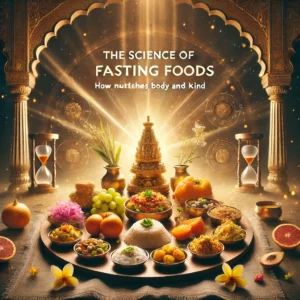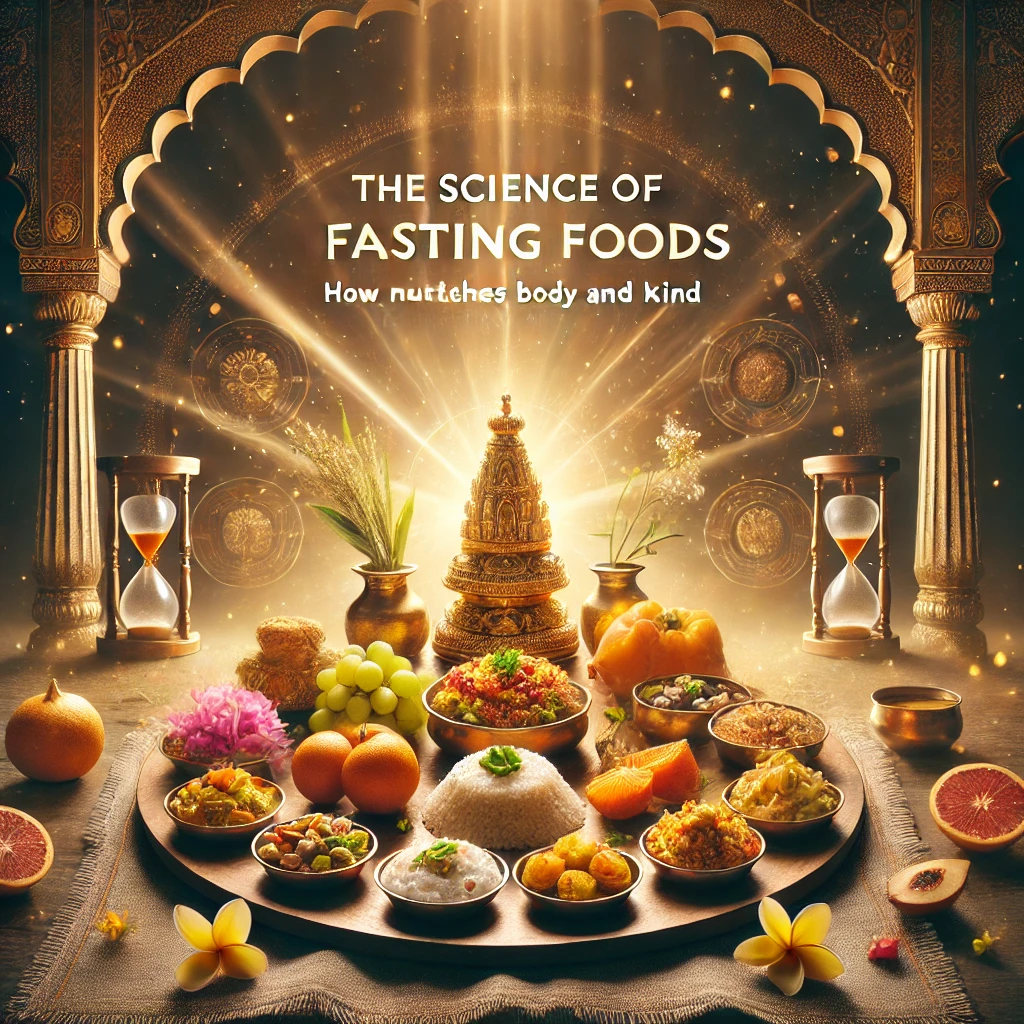
Scientific benefits of fasting foods in Hindu traditions
The Science Behind Fasting Foods (Vrat Ka Khana)
Fasting (vrat) has been an integral part of Indian culture for centuries, often associated with religious and spiritual practices. While fasting is deeply rooted in devotion, it also has significant scientific and health benefits. The foods consumed during fasting, commonly known as ‘vrat ka khana,’ are carefully selected to provide nutrition while aiding detoxification and improving digestion. But what is the science behind these fasting foods? Let’s explore the rationale behind their selection and how they benefit the body.
1. Nutritional Balance and Digestive Rest
During fasting, heavy and difficult-to-digest foods such as grains, pulses, and certain vegetables are avoided. Instead, alternatives like buckwheat (kuttu), water chestnut (singhara), sago (sabudana), and amaranth (rajgira) are consumed. These are light on the stomach and easy to digest while being rich in essential nutrients.
Buckwheat (Kuttu Atta): High in protein, fiber, and antioxidants, it helps maintain energy levels while keeping digestion smooth.
Water Chestnut Flour (Singhara Atta): Rich in potassium and low in sodium, it aids in maintaining electrolyte balance.
Amaranth (Rajgira): A powerhouse of calcium, iron, and amino acids, supporting overall strength and immunity.
Sago (Sabudana): High in carbohydrates, it provides instant energy and prevents fatigue during fasting.
2. Detoxification and Cleansing
One of the main scientific benefits of fasting is detoxification. By avoiding processed and heavy foods, the body gets a chance to cleanse itself from accumulated toxins. Fruits, dairy products, and nuts, which are staples of vrat diets, help in this process:
Fruits: Rich in fiber, vitamins, and antioxidants, they help flush out toxins and improve hydration.
Dairy Products (Milk, Yogurt, Paneer): Provide essential calcium and protein, ensuring muscle and bone health.
Nuts (Almonds, Cashews, Walnuts): Offer healthy fats and proteins, keeping hunger at bay while supporting brain function.
Coconut Water: A natural detoxifier, it replenishes electrolytes and prevents dehydration during fasting.
Table of Contents

Scientific benefits of fasting foods in Hindu traditions
3. Alkalizing Effect on the Body
Most fasting foods have an alkalizing effect on the body, which helps maintain pH balance and reduces acidity. Regular grains like wheat and rice can lead to acidity, but fasting alternatives like kuttu, singhara, and rajgira help in neutralizing stomach acids, reducing bloating and discomfort.
Lemon Water: Often consumed during fasting, it helps balance pH levels and aids digestion.
Cucumber and Curd: These cooling foods provide hydration and prevent acidity.
4. Stabilizing Blood Sugar Levels
Contrary to popular belief, fasting does not necessarily lead to a drop in blood sugar levels. The right combination of vrat foods ensures a slow and steady release of glucose into the bloodstream, preventing sudden spikes or crashes.
Makhana (Fox Nuts): Low in glycemic index, they help regulate blood sugar while providing essential micronutrients.
Sweet Potatoes: A great source of complex carbohydrates and fiber, they sustain energy levels for long durations.
Rock Salt (Sendha Namak): Unlike refined salt, it contains minerals that help maintain hydration and electrolyte balance.
Flaxseeds and Chia Seeds: Rich in omega-3 fatty acids and fiber, they help in stabilizing sugar levels while providing sustained energy.
5. Boosting Metabolism and Immunity
Fasting foods help boost metabolism and improve overall immunity, making the body more resilient to illnesses.
Ginger and Tulsi Tea: Known for their antibacterial and anti-inflammatory properties, these drinks help in boosting immunity and digestion.
Honey and Dry Fruits: Natural energy boosters, they help in revitalizing the body without causing sugar spikes.
6. Spiritual and Mental Benefits
From a psychological perspective, fasting helps in mental clarity and discipline. The selective food intake ensures that the digestive system gets a break, allowing the mind to focus better on prayers, meditation, and self-reflection. Many fasting foods also have stress-reducing properties, such as nuts, dairy, and fresh fruits, which help maintain calmness and emotional stability.
Saffron and Cardamom-Infused Milk: Known for their calming effects, they promote relaxation and enhance cognitive functions.

Conclusion
The selection of fasting foods in Indian traditions is not random but deeply rooted in science. These foods provide energy, support detoxification, maintain digestive health, stabilize blood sugar levels, and boost metabolism and immunity, all while aligning with spiritual practices. By following the principles of vrat ka khana, one can experience both physical well-being and mental peace, making fasting not just a religious ritual but a holistic health practice.
Next time you observe a fast, remember that your vrat diet is not just about tradition—it’s also a well-designed, nutritious way to cleanse and rejuvenate your body and mind. Embracing these fasting foods in your diet even beyond vrat days can promote overall health and well-being.
FAQs about “The Science of Fasting Foods: How ‘Vrat Ka Khana’ Nourishes Body and Mind”:
- What is the significance of fasting foods (Vrat Ka Khana) in Indian traditions?
Fasting foods have been an integral part of Indian culture and spiritual practices for centuries. They are designed to cleanse the body, promote self-discipline, and enhance spiritual focus while providing essential nutrients.
- How does fasting impact the body scientifically?
Fasting triggers autophagy (cellular detox), improves digestion, regulates metabolism, and helps in weight management. It also enhances insulin sensitivity and supports overall well-being.
- Why are certain foods restricted during fasting?
Foods like grains, pulses, and regular salt are avoided because they are considered heavy and difficult to digest. Instead, fasting-friendly ingredients like buckwheat, water chestnut flour, and rock salt are used to maintain digestive balance.
- What are the best foods to eat during fasting?
Nutrient-rich foods such as sabudana (tapioca pearls), makhana (fox nuts), singhara (water chestnut flour), kuttu (buckwheat), fruits, dairy, and dry fruits provide sustained energy and essential nutrients during fasting.
- Does fasting help in detoxification?
Yes, fasting allows the digestive system to rest, promotes the elimination of toxins, and rejuvenates the body’s natural healing processes.
- Can fasting improve mental health?
Fasting can enhance mental clarity, reduce stress, and improve focus by regulating brain function and increasing the production of neurotrophic factors.
- Why is rock salt (Sendha Namak) used instead of regular salt?
Rock salt is unprocessed and contains essential minerals, making it a healthier alternative that aligns with fasting traditions.
- Can fasting foods be consumed by people with health conditions?
People with diabetes, hypertension, or other medical conditions should consult a doctor before fasting. Modifications like eating small, balanced meals can help maintain health during fasting.
- Is fasting beneficial for weight loss?
Intermittent fasting, when done correctly, can aid weight loss by improving metabolism and reducing calorie intake while maintaining nutritional balance.
- How can one maintain energy levels during fasting?
Consuming energy-boosting foods like bananas, dry fruits, coconut water, and dairy products ensures sustained energy and prevents fatigue during fasting.
Summary
Fasting foods, or Vrat ka Khana, have been an integral part of Indian culture for centuries, blending spiritual traditions with scientific principles of nutrition and well-being. These foods are carefully selected to provide essential nutrients while ensuring easy digestion and sustained energy during fasting periods. Unlike regular meals, fasting foods emphasize light, natural, and easily digestible ingredients that help detoxify the body and restore balance.
Common fasting staples include sabudana (tapioca pearls), buckwheat, amaranth, water chestnut flour, fox nuts (makhana), and fresh fruits. These ingredients are naturally gluten-free, rich in fiber, and packed with essential vitamins and minerals. They provide slow-releasing carbohydrates, ensuring a steady supply of energy without causing spikes in blood sugar levels. Healthy fats from nuts, seeds, and dairy products further support endurance and satiety, preventing fatigue and weakness during fasting.
From a scientific perspective, fasting triggers autophagy—a natural process where the body removes damaged cells and regenerates new ones, promoting cellular repair and longevity. Studies also suggest that intermittent fasting helps regulate insulin levels, improve metabolism, enhance brain function, and reduce inflammation. Additionally, fasting allows the digestive system to rest, improving gut health and detoxification.
Beyond physical benefits, fasting is known to have a profound impact on mental and emotional well-being. Many people report increased mindfulness, focus, and inner peace during fasting, as the practice encourages discipline and self-awareness. The carefully chosen foods play a role in maintaining a calm and balanced mind, further enhancing spiritual experiences.
Thus, Vrat ka Khana is not merely about dietary restrictions but a holistic approach to rejuvenation. By nourishing the body with nutrient-dense, easily digestible foods and aligning with ancient wisdom, fasting becomes a powerful tool for overall health, vitality, and spiritual growth.
Unlock the Ancient Wisdom of Sanatan Dharma – Join Us on YouTube!
👉 Subscribe now to Prachin Sanatan Dharma and embark on a journey of enlightenment.
Explore timeless teachings, spiritual insights, and cultural richness on our YouTube channel, Prachin Sanatan Dharma. Dive deep into the essence of Sanatan Dharma through captivating videos that inspire and educate.
Related Articles
- Restful Nights: Ayurvedic Remedies and Traditional Indian Practices to Overcome Insomnia and Late-Night Habits
- The Tridevi: Lakshmi, Saraswati, and Parvati – Their Roles and Powers
- “Divine Creatures of Ancient Indian Scriptures: Exploring the Role of Animals in the Vedas, Puranas, and Mahabharata”
- Nature and Spirituality: Exploring the Sacred Essence of the Himalayas, Ganga, and Other Natural Wonders”
- “Reviving the Gurukul System: Relevance and Lessons for Modern Education”
- “Exploring Greek and Indian Mythology: Similarities Between Greek and Indian Mythology “
- “Embracing Sattvic Living: Harmonizing Mind, Body, and Soul Through Food and Lifestyle”
- “Charity and Prosperity: Exploring the Concept of Daan and Its Financial Relevance in Modern Life”
- How to Build an Eco-Friendly Home Inspired by Vastu Shastra
- Comparison of Ancient and Modern Sports: How Traditional Sports Have Influenced Contemporary Games
- “Timeless Lessons from Ancient Tales: Linking Samudra Manthan and Ganga’s Descent to Modern Ecological Challenges”
- “Reviving Sanskrit: How AI is Preserving Ancient Languages for the Future”
- “Mathura: The Sacred Land of Lord Krishna’s Divine Leelas”
- Investing for Future Generations: Lessons from Indian Traditions on Legacy Building and Wealth Preservation
- “Ancient Indian Wisdom: Timeless Lessons for Tackling Today’s Climate Crisis”
- “Artificial Intelligence and Spirituality: Transforming Ancient Practices for the Modern World”
- “Gold and Real Estate in India: Timeless Assets Shaping Financial Strategies”
- Tradition Meets Innovation: The Evolution of Technology in Hindu Rituals
- End-of-World Myths: Exploring Kali Yuga in Hinduism and Ragnarök in Norse Mythology
- Garuda, Pegasus, and Dragons: The Universal Ties of Mythical Beasts Across Cultures
- “Ancient Vimanas: Mythical Flying Machines or Evidence of Advanced Technology?”
- Time Travel in Hindu Mythology: The Fascinating Tales of Kakudmi and King Raivata
- “Divine Feminine Power in Hindu Mythology: The Legends of Durga, Saraswati, and Lakshmi”
- “Divine Beings of Sanatan Dharma: The Spiritual Significance of Sacred Animals in Hinduism”
- “Symbolism in Mythological Art: Unlocking Hidden Meanings in Ancient Temple Carvings”
- “Exploring Technological Advancements in Ancient India and Civilizations: Vimana, Metallurgy, & Water Management systems”
- Unveiling the Mysteries: Ancient Temples of Sanatan Dharma , Mysterious Temples of India
- “The Scientific Knowledge of Sanatan Dharma: Ancient Wisdom Meets Modern Science”
- Ancient Indian Sports and Games: Celebrating a Legacy of Skill, Strength & Strategy”
- “Exploring the Cosmic Link: The Connection Between Astronomy and Vedic Astrology”
- The Power of Sanskrit: Unlocking the Divine Language of the Gods
- “The End of Kaliyuga: A Sanatan Insight into the World’s Final Chapter”
- Explore more articles on Prachin Sanatan Yuga.
Scientific benefits of fasting foods in Hindu traditions Scientific benefits of fasting foods in Hindu traditions Scientific benefits of fasting foods in Hindu traditions Scientific benefits of fasting foods in Hindu traditions Scientific benefits of fasting foods in Hindu traditions Scientific benefits of fasting foods in Hindu traditions Scientific benefits of fasting foods in Hindu traditions
Scientific benefits of fasting foods in Hindu traditions Scientific benefits of fasting foods in Hindu traditions Scientific benefits of fasting foods in Hindu traditions Scientific benefits of fasting foods in Hindu traditions Scientific benefits of fasting foods in Hindu traditions Scientific benefits of fasting foods in Hindu traditions Scientific benefits of fasting foods in Hindu traditions
Scientific benefits of fasting foods in Hindu traditions Scientific benefits of fasting foods in Hindu traditions Scientific benefits of fasting foods in Hindu traditions Scientific benefits of fasting foods in Hindu traditions Scientific benefits of fasting foods in Hindu traditions Scientific benefits of fasting foods in Hindu traditions Scientific benefits of fasting foods in Hindu traditions
Scientific benefits of fasting foods in Hindu traditions Scientific benefits of fasting foods in Hindu traditions Scientific benefits of fasting foods in Hindu traditions Scientific benefits of fasting foods in Hindu traditions Scientific benefits of fasting foods in Hindu traditions Scientific benefits of fasting foods in Hindu traditions Scientific benefits of fasting foods in Hindu traditions
Fasting (vrat) has been an integral part of Indian culture for centuries, often associated with religious and spiritual practices. While fasting is deeply rooted in devotion, it also has significant scientific and health benefits. The foods consumed during fasting, commonly known as ‘vrat ka khana,’ are carefully selected to provide nutrition while aiding detoxification and improving digestion. But what is the science behind these fasting foods? Let’s explore the rationale behind their selection and how they benefit the body.
Fasting (vrat) has been an integral part of Indian culture for centuries, often associated with religious and spiritual practices. While fasting is deeply rooted in devotion, it also has significant scientific and health benefits. The foods consumed during fasting, commonly known as ‘vrat ka khana,’ are carefully selected to provide nutrition while aiding detoxification and improving digestion. But what is the science behind these fasting foods? Let’s explore the rationale behind their selection and how they benefit the body.
Fasting (vrat) has been an integral part of Indian culture for centuries, often associated with religious and spiritual practices. While fasting is deeply rooted in devotion, it also has significant scientific and health benefits. The foods consumed during fasting, commonly known as ‘vrat ka khana,’ are carefully selected to provide nutrition while aiding detoxification and improving digestion. But what is the science behind these fasting foods? Let’s explore the rationale behind their selection and how they benefit the body.
Fasting (vrat) has been an integral part of Indian culture for centuries, often associated with religious and spiritual practices. While fasting is deeply rooted in devotion, it also has significant scientific and health benefits. The foods consumed during fasting, commonly known as ‘vrat ka khana,’ are carefully selected to provide nutrition while aiding detoxification and improving digestion. But what is the science behind these fasting foods? Let’s explore the rationale behind their selection and how they benefit the body.
Scientific benefits of fasting foods in Hindu traditions Scientific benefits of fasting foods in Hindu traditions Scientific benefits of fasting foods in Hindu traditions Scientific benefits of fasting foods in Hindu traditions Scientific benefits of fasting foods in Hindu traditions Scientific benefits of fasting foods in Hindu traditions Scientific benefits of fasting foods in Hindu traditions
Fasting (vrat) has been an integral part of Indian culture for centuries, often associated with religious and spiritual practices. While fasting is deeply rooted in devotion, it also has significant scientific and health benefits. The foods consumed during fasting, commonly known as ‘vrat ka khana,’ are carefully selected to provide nutrition while aiding detoxification and improving digestion. But what is the science behind these fasting foods? Let’s explore the rationale behind their selection and how they benefit the body.
